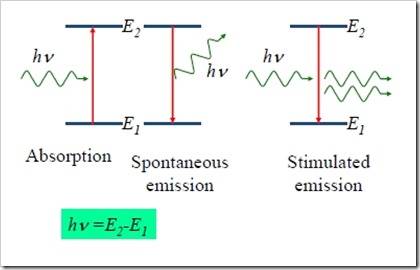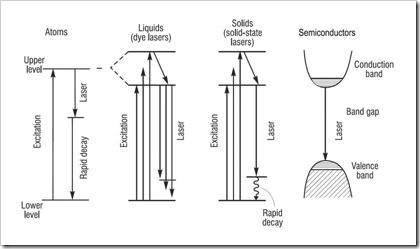Principles of Operating of Lasers
Types and Operating principles of Lasers:
After the invention of the Helium-Neon gas laser, it was found that many other gases are capable to amplify light coherently. There are many different gases that are used to design gas lasers that are used for a wide range of applications. The helium-neon laser (HENE) is capable of operating at many different wavelengths, although the vast majority are engineered to operate at 633 nm; these relatively low cost but highly coherent lasers are extremely common in optical research and academic laboratories.

Carbon dioxide lasers that are used for commercial purpose emits many hundreds of watts in a single spatial mode that can be concentrated in a tine spot.
This emission is in the thermal infrared at 10.6 µm; Such lasers are routinely used in industry for cutting and welding. A carbon dioxide laser’s efficiency is however very high: approximately higher than 30%. Argon-ion lasers can work at a range of lasing transactions between 351 and 528.7 nm.
One or more than of these transactions can be lasing at the same time depending upon the optical design; 458 nm, 514.5 nm, and 488 nm are the most commonly used lines.
Nitrogen transverse electrical discharge into a gas at atmospheric pressure (TEA) laser is an inexpensive gas laser, often used in-house by hobbyists, that produces amorphous UV light at 337.1 nm.

Metal ion lasers are basically gas lasers that are used to produce deep ultraviolet wavelengths. Two examples of this are neon-copper (NeCu) 248 nm and Helium-silver (HeAg) 224 nm. Like all low-pressure gas lasers, these lasers have fairly narrow oscillation linewidths, less than 3 GHz (0.5 picometers) in gain media, making them candidates for use in fluorescence suppressed Raman spectroscopy. The optics laser technology used by the thin fused silica windows suppliers and optic lens supplier are of very high efficiency.
Its invention
In 1992, it was demonstrated that lasing without controlling or maintaining the medium gets excited into a population inversion in the sodium gas. The same experiment was demonstrated in 1995 in rubidium gas by various international teams.
This was accomplished by introducing a ground electron transition between the two paths and using an external maser to induce «optical transparency» in the medium by interfering destructively so that any energy was absorbed by the ground electrons the possibility has been ruled out.














